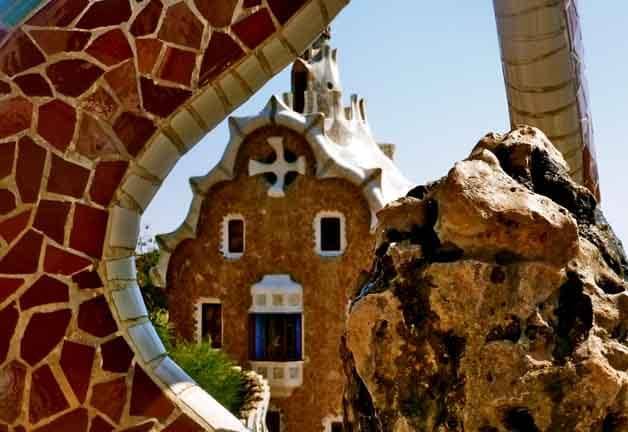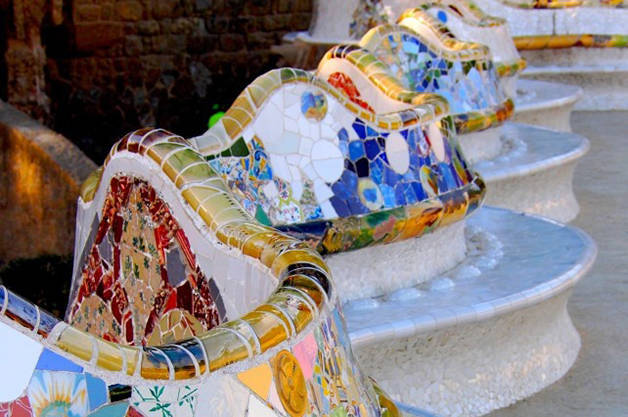Parc Güell: history and secrets of the most beautiful park in Barcelona

Parc Güell which you will also see written Park Güell is a UNESCO world heritage site. It is one of the symbols of Barcelona and it is easy to see why when you enter this uncommon place that came straight from the wonderful imagination of Gaudí! Discover with us the secrets and history of Parc Güell!
- To read also: Park Güell: tour, prices and useful information
Parc Güell history and secrets: an ambitious project unfinished
A residence for the middle classes
Parc Güell was born out of the collaboration between the architect Gaudí and his patron Eusebi Güell. The original idea was to construct a garden city with beautiful houses, caretakers’ lodges, a market, a school and a church. It was planned that the infrastructure would not occupy more space than the green areas.
Parc Güell was designed as a closed and controlled residence, for well-off people.

Abandoned project
Unfortunately, Güell and Gaudí’s project was not as successful as they hoped. The rich Catalan people thought the area was too far from the city centre (if you think it is far from town now that the city has spread, imagine what it was like in the 1900s!).
So works stopped in 1914, and the park remained as we know it today. Of the 60 planned houses, only two were built: the Casa Larrard for Eusebi Güell, and a watch house bought by Gaudí.
In 1922, the city of Barcelona bought the whole lot and transformed it into a public park.

Parc Güell history and secrets: an earthly paradise
The public can therefore come and discover this unusual park. There are several entrances.
- We advise you to use the main entrance, or the South gate. According to Gaudí, this entrance to Parc Güell is an allegory for arriving in Paradise. There are fountains, fantastic creatures (the famous mosaic salamander) and steps which trace the path to heaven.
Here is a dreamlike world in perfect communion with nature. Everything is transformed: straight lines are transformed into dancing curves, everything leans, and all is colourful, wavy and magical!
Parc Güell history and secrets: ode to nature
Importance of colours
Everything by Gaudí points to nature and Parc Güell is no exception. This quote from the architect will help you understand his colourful world:
« Ornementation was, is and will be colourful. Nature does not present us with any object in monochrome, totally uniform. Everything in vegetation, in the animal kingdom, and in minerals carries a more or less vivid contrast in colour. That is why we too must colour, in part or wholly, the various archetectonic parts, of which the colour will perhaps fade but which the passage of time will re-cover with the precious and original gloss provided by age.”

Copying nature without imitating it
Gaudí was inspired by the colours and shapes of nature but he gave them his own twist.
At Parc Güell, pathways undulate like rivers, cast iron palm leaves are built onto gates, and stone columns look like tree bark…see if you can find all the details that Gaudí dotted around the park!
Respect for land
Gaudí also bore in mind the constraints of the terrain, so the significant unevenness allowed Gaudí to imagine a sort of spiritual ascension echoing that of the park’s hill, and allowing you to arrive at a chapel built on the highest point of the park.
In the same way, the park’s arcs and viaducts resembling caves were designed in remembrance of the prehistoric remains that were found on the site during construction.
A symbolist park
The park is also full of religious and political symbols held dear by its creators.
Catalan lands are represented on the fountains on the principal staircase. One of them is notably emblazoned with the Catalan coat of arms and a snake, symbol of medicine but also of the bronze snake used by Moses leaving Egypt.
On another fountain a salamander represents the city of Nimes where Eusebi Güell grew up. The famous animal reclines in its nook of yellow and red, the colours of Catalonia.

